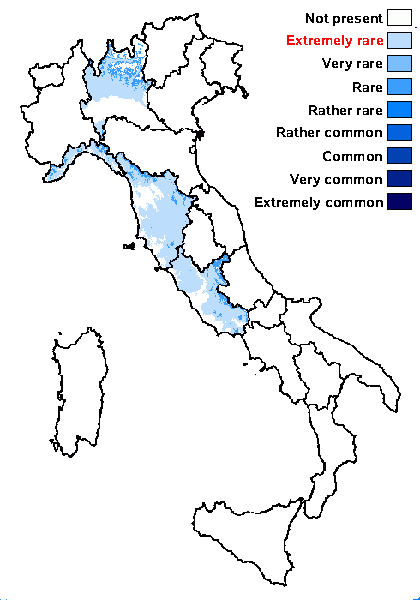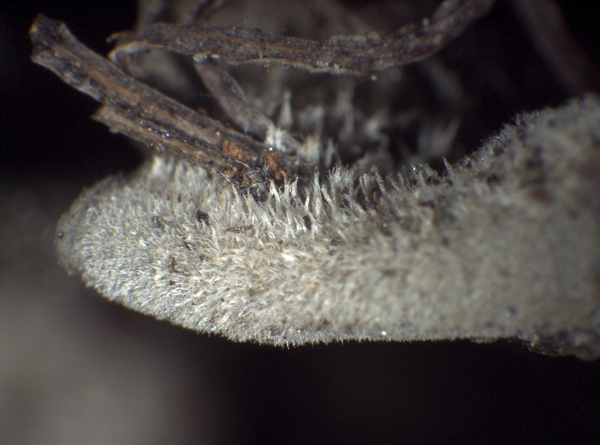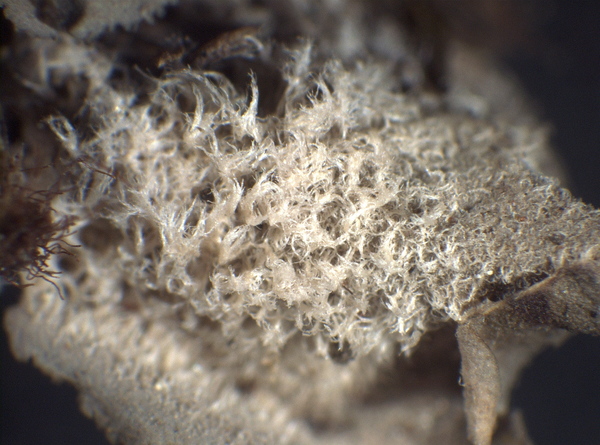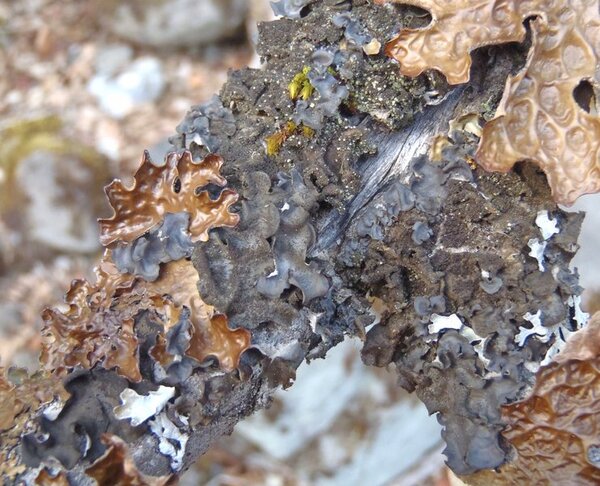Leptogium burnetiae C.W. Dodge
Beih. Nova Hedwigia, 12: 120, 1964.
Synonyms: Leptogium menziesii f. fuliginosum Müll. Arg.; Leptogium menziesii var. coralloideum Jatta
Distribution: N - Lomb, Lig (Brunialti & al. 1999). C - Tosc (Benesperi & al. 2007), Laz (Ravera 2008).
Description: Thallus foliose, subgelatinous when wet, bluish grey, 3-10(-15) cm wide, loosely adnate; lobes elongate, 3-10(-15) mm broad, 100-150 µm thick, with rounded apices and often upturned margins, isidiate, the isidia cylindrical, simple or branched-coralloid, often clustered, usually concolorous with lobes, sometimes with a minute pit at apex. Lower surface with a dense white tomentum of cylindrical, 0.2-1 mm long hairs composed of cylindrical cells. Upper and lower cortex consisting of a single layer of cells; inner part without medulla, with loosely interwoven chains of Nostoc and hyphae. Apothecia rare, lecanorine, substipitate, 0.5-3 mm across, with a brown to red-brown, flat to convex disc, and an isidiate, persistent thalline margin. Proper exciple euparaplectenchymatous, 20-25 µm wide laterally; epithecium brown; hymenium colourless, 100-130 µm high; paraphyses mostly simple, 1-2 µm thick at mid-level, the apical cells slightly swollen; hypothecium colourless or pale yellow Asci 8-spored, cylindrical-clavate, the apex strongly thickened, the apical dome K/I+ pale blue, with a downwardly projecting K/I+ deep blue tubular structure. Ascospores submuriform, hyaline, ellipsoid to subfusiform, 30-45 x 12-18 µm. Photobiont cyanobacterial (Nostoc, the cells in long chains). Spot tests: all negative. Chemistry: without lichen substances.Note: a mild-temperate species found on the often mossy bark of isolated trees, especially Fraxinus. A revision of herbarium material is much needed: several Italian records of L. saturninum could refer to this species.
Growth form: Foliose, broad lobed
Substrata: bark
Photobiont: cyanobacteria, filamentous (e.g. Nostoc, Scytonema)
Reproductive strategy: mainly asexual, by soredia, or soredia-like structures (e.g. blastidia)
Most common in areas with a humid-warm climate (e.g. most of Tyrrenian Italy)
Commonnes-rarity: (info)
Alpine belt: absent
Subalpine belt: absent
Oromediterranean belt: absent
Montane belt: rare
Submediterranean belt: extremely rare
Padanian area: absent
Humid submediterranean belt: extremely rare
Humid mediterranean belt: absent
Dry mediterranean belt: absent

Predictive model
Herbarium samples

Silvered Vinyl Lichen Wikimedia Commons (uploaded by Amada 44) – CC BY-SA 2.0
Canada, British Columbia


E. Pittao; Owner: Department of Life Sciences, University of Trieste
Herbarium: TSB (27238)
2008.03.10
lower surface


E. Pittao; Owner: Department of Life Sciences, University of Trieste
Herbarium: TSB (27238)
2008.03.10
lower surface


E. Pittao; Owner: Department of Life Sciences, University of Trieste
Herbarium: TSB (29224)
2008.03.10
lower surface
Growth form: Foliose, broad lobed
Substrata: bark
Photobiont: cyanobacteria, filamentous (e.g. Nostoc, Scytonema)
Reproductive strategy: mainly asexual, by soredia, or soredia-like structures (e.g. blastidia)
Most common in areas with a humid-warm climate (e.g. most of Tyrrenian Italy)
Commonnes-rarity: (info)
Alpine belt: absent
Subalpine belt: absent
Oromediterranean belt: absent
Montane belt: rare
Submediterranean belt: extremely rare
Padanian area: absent
Humid submediterranean belt: extremely rare
Humid mediterranean belt: absent
Dry mediterranean belt: absent

Predictive model
| Herbarium samples |

Silvered Vinyl Lichen Wikimedia Commons (uploaded by Amada 44) – CC BY-SA 2.0
Canada, British Columbia


E. Pittao; Owner: Department of Life Sciences, University of Trieste
Herbarium: TSB (27238)
2008.03.10
lower surface


E. Pittao; Owner: Department of Life Sciences, University of Trieste
Herbarium: TSB (27238)
2008.03.10
lower surface


 Index Fungorum
Index Fungorum
 GBIF
GBIF



